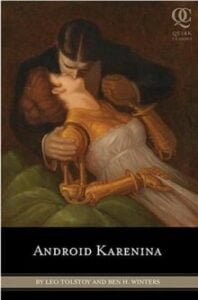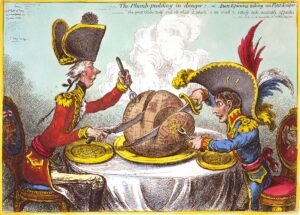Satire in Literature?
‘A work infused with humour and satire…’
‘A biting social satire…’
‘A social commentary oozing satire and acerbic wit…’
It seems that every poem or novel published these days is a satirical commentary on the flaws in modern society. Is there really such a plethora of witty contemporary satirists in our midst – or (asks the cynic in me) is this just sneaky spin by publicists to re-package otherwise quite pedestrian work? What even is satire in literature?
When setting out to write your own scathing satirical opus, I don’t want you getting your parody confused with your spoof and – heavens forbid – writing a sequel to Android Karenina instead of the next Animal Farm. So let’s look at how these techniques differ and overlap.
Parody and Cyborgs

Android Karenina (2010), by Ben H. Winters, falls into the category of parody. Parody is classed as imitation of a specific work for comedic purposes, and it is usually obvious what the targeted work is. For example, Android Karenina, part of the literary mash up genre, is clearly a play on Anna Karenina, written by Tolstoy in 1878. While it retains the characters from the original, the novel goes on to juxtapose tsarist Russia with steampunk, time travel, space travel and cyborgs. Winters uses two literary devices – incongruity and subversion – to create parody. Incongruity; the novel Anna Karenina conforms to literary realism and so, being set in 19th century Imperial Russia, we wouldn’t expect to see cyborgs wandering about. Subversion; not only is steampunk anachronistic, but its aesthetic is anathema to the formal style of Anna and Vronsky, and this shatters our expectations and the world-building blueprint we would have.
Other examples of parody novels are:
Bored of the Rings (1969) – Douglas Kenney and Henry Beard lampoon Tolkien’s behemoth
Snowball’s Chance (2002) – John Reed’s sequel to Animal Farm
Fifty Shames of Earl Grey (2012) – there are dozens of Fifty Shades rip offs, this one was picked for the wonderfully named author, Fanny Merkin (aka Andrew Shaffer)
Pride and Prejudice and Zombies (2009) – by Seth Grahame-Smith. Another mash-up novel; does what it says on the tin
Shamela (1741) – Henry Fielding’s lambasting attack on Samuel Richardson’s popular Pamela (1740), proving that parody novels aren’t a modern invention
Don’t Scream or I’ll Spoof
Spoof is similar to parody; however, it takes a broader approach by mocking the hallmarks and conventions of an entire genre, often incorporating and pastiching the defining characteristics from several works. It isn’t identifiable to one specific movie or work, but cherry picks the best (or worst) of the genre. So, for example, the Scary Movie franchise spoofs teenage horror films and tropes, through mimicry and exaggeration of conventions such as the jump scare, sequels, stereotypical characters, dark/secluded setting, the male gaze, and violence and gore, etc. It ridicules movies such as The Blair Witch Project (1999), Scream (1996), and I Know What You Did Last Summer (1997).
Satire as a political tool

What do Spitting Image and Animal Farm have in common?
Answer: They are both examples of political satire.
Satire is often more subtle than parody or spoof while still using humour to comment on or criticise an aspect of people/culture/politics/society. Whereas spoof and parody are usually employed (but not exclusively) for entertainment, satire has a point to make. Spoof, parody and satire are not precious entities and will often work together; the 1980s tv show Spitting Image was both parody and satire. The puppets parodied specific individuals, e.g the famous Margaret Thatcher puppet, however the show overall commented on and satirized the politics of the day. As well as humour, metaphor is a common device often used in satire, as is hyperbole and irony.
Thatcher’s schnoz-tastic puppet was based on the caricatures of political cartoonist Gerald Scarfe, known for his grotesque and surreal style. Political cartoons have been a major vehicle for satire in the UK since the 18th century, one of the most famous being ‘The Plumb-pudding in danger’ by James Gillray (1757-1815).

“Just because you’re paranoid doesn’t mean they aren’t after you.”
Examples of satire in literature include:
American Psycho (1991) – Bret Easton Ellis uses caricature and hyperbole to ridicule and expose the excesses of 1980s Wall St, itself a metaphor for wealth and power. Bateman’s relentless obsession with the banal and superficial – such as cleansing products, clothes, and hair mocks both societal materialism and fragile masculinity.
Catch-22 (1961), by Jospeh Heller is so influential that the term is now part of everyday speech. Heller used satire to highlight the absurdities of war,
“Just because you’re paranoid doesn’t mean they aren’t after you.”
– Joseph Heller, Catch-22
Animal Farm (1945) – George Orwell uses allegory, analogy and metaphor to critique the Russian revolution, however, it can be interpreted more broadly as a warning of how seductive power and totalitarianism can be.
Madame Bruttipedi’s Masterclass in Satire

Madame Bruttipedi is a character invented for Power Cut. She embodies the pin-up girl vibe generally, taking elements from the genre as a whole, making her spoof rather than parody. Had she been illustrated splashing about in a martini glass and called Gita Von Sleaze, then she would have been a parody of Dita Von Teese.
What makes a satirical Madame?
Madame Bruttipedi employs several satirical devices. Firstly caricature or hyperbole; Madame is a stereotypical pin up model, incorporating all the tropes of male fantasy of a woman to the point of almost being a caricature of the genre. She is a highly sexualised version of a woman, her hair, make-up, waist, breasts, outfit – until we see her feet. Whoa – what are they??? We weren’t expecting bunions to be peeking out the stockings. Bunions are sexy, it’s clearly incongruity – a device touched on above. Ugly feet don’t belong in the fantasy – ridiculing the expectation of female beauty. She also makes a statement about society’s expectation of perceived perfection – with her stinking feet Madame is far from perfect. Madame is perfect on the surface, but the reality is she is rotting from the inside out. Satire often plays a role is social commentary, and this is often achieved through metaphor. Madame can and should be interpreted metaphorically. A metaphor of what? You tell me.
Madame also subverts our expectation of what her role might be. Her look is very striking and clearly based in the glamour world, but she is a bibliotherapist and foot dominatrix. What on God’s earth is a foot dominatrix many of you will be asking? What the hell is a bibliotherapist? And here the satire moves on to the elitism of the literary world;
“Madame will prescribe books for you that reveal new perspectives, shine light on your potential and re-enchant the world for you.”
(Power Cut Issue 1)
Do we really believe that she can do this by telling us what books to read? Does Madame succeed as a form of satire in literature? What point she is making – I’ll leave for you to decide.
If you enjoy what we do, please consider supporting us by purchasing a magazine, or a bibliotherapy prescription by the wonderfully satirical Madame Bruttipedi.
